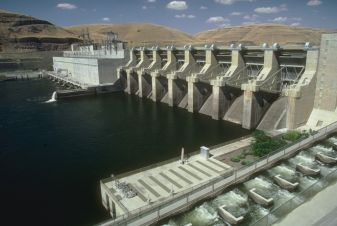forum
library
tutorial
contact

Mismanagement, Not Dams,
Killing Salmon Runs
by Don Jackson
Walla Walla Union-Bulletin, December 16, 2018
|
the film forum library tutorial contact |

|
Mismanagement, Not Dams,
by Don Jackson
|
But as one old fellow said, why save any fish for the next generation -- nobody saved any buffalo for us.
 I would like to present some history on the four Lower Snake River dams.
I would like to present some history on the four Lower Snake River dams.
When the dams were built, only half of the powerhouse was built, and only three generator units were installed. When money became available the powerhouse was finished and three more units installed.
After Little Goose and Lower Granite dams went on line, there were record flows in the Snake River during the salmon migration, and only half of the water could pass through the three units; the other half had to go through the spillways, creating supersaturated water that is deadly to smolts and adult salmon.
The turbines in the dams didn’t kill fish then, and they don’t kill fish now. Spilling water is what killed the salmon runs. The only option to save our fish was to transport them around the dams.
National Marine Fisheries set up at Little Goose and began transporting smolts in tanker trucks, releasing them below Bonneville Dam, which saved a small portion of our fish runs. Fish continued to die by the millions until the other three units were installed and no water had to go through the spillways. The tanker trucks were replaced by modern-day barges to transport the smolts downstream.
Several new fish hatcheries were built, including Lyons Ferry, and a huge upgrade on the Tucannon Hatchery. These three things worked, and in a few years we had record number of steelhead and Chinook salmon returning to the Snake River.
The only ammunition dam breachers have is low fish numbers, so having record numbers is bad news for them. They went to court, and some clueless judge ordered water to be spilled over our dams.
2015 was a warm, low-water year, and only 13 percent of the smolts were transported, instead of 50 percent. Hatchery production has been curtailed by several million fish each year. The things that were done to produce record returns of salmon are being destroyed by the dam breachers and fish mismanagers.
For several years, the Tucannon River per hours fished produced more steelhead than any river in the state.
Deciding hatchery fish were bad in the Tucannon, our fish mismanages stopped hatchery releases, and the catch went from about 1,800 a year to 15 or 16 in a few years. But as one old fellow said, why save any fish for the next generation -- nobody saved any buffalo for us.
learn more on topics covered in the film
see the video
read the script
learn the songs
discussion forum
